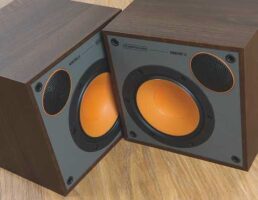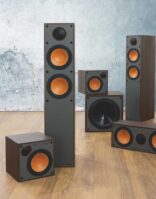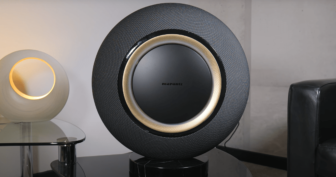Steve Withers samples Monitor Audio’s budget floorstanding speaker option
Monitor Audio has broken with tradition recently, eschewing its normal habit of naming a speaker range after a precious metal, and going for something a bit more prosaic instead. The brand famous for its Bronze, Silver, Gold and Platinum ranges appears to have lost its copy of the periodic table.
PRODUCT: Affordable 5.1 speaker system
Position: Sits below Bronze on the Monitor Audio podium
PEERS: Q Acoustics 3000i; Acoustic Energy 100; Polk Signature
1. Want to go bigger? A Monitor 300 tower speaker, with twin 6.5 woofers, is available
The two most recent additions to its lineup are the high-end Studio, and the more wallet-friendly Monitor.
The latter is particularly interesting because it appears to promise Monitor Audio performance for those on a budget. The new range includes the 300 and 200 floorstanders; the 100 and 50 bookshelf speakers; the C150 centre speaker; and the MRW-10 active subwoofer.
Contents
You can obviously build a system using different combinations of speakers, and there’s nothing stopping you from adding as many channels as you like. Monitor Audio doesn’t make a dedicated Dolby Atmos unit, but it does make in-ceiling models for the custom install market which could be used for the overhead channels.
For this review, I ran a 5.1 system with a pair of 200s and a C150 at the front, a pair of 50s for the surrounds, and a MRW-10 for the low-end grunt. That lot will set you back, which is pretty good value.
The question is: how many corners has Monitor Audio had to cut to hit this lower price point? To be honest, my initial impressions weren’t encouraging; clearly the design team was given a day off when the Monitors were conceived: these are easily the most boring speakers I’ve seen in a while.
It’s almost as though Monitor Audio realised this, and quickly added the orange bass drivers to give the speakers a ‘playful twist’, as the company puts it. I know beauty is in the eye of the beholder, but to me they just make an already budget speaker look even more budget. I definitely prefer my drivers black.
Borrowing from Bronze
All speakers in the range are plain wooden boxes, with a grey baffle and a choice of black, white or walnut matt finishes. There are also black cloth grilles, which use fasteners rather than magnets to attach to the baffle. The floorstanders include outrigger feet to improve stability, and there are two sets of binding posts for those who bi-wire.
While the design and build quality of the Monitors might reflect the range’s entry-level aspirations, Monitor Audio has at least trickled down innovations from its award-winning Bronze range. All the speakers use 1in C-CAM (Ceramic-Coated Aluminium Magnesium) dome tweeters, and those orange translucent 5.5in MMP II (Metal Matrix Polymer) driver cones. That’s good news, because you can mix and match speakers from the range and keep the system tonally balanced.
The floorstanding 200 partners its tweeter with both a midrange and bass driver. The cabinet has a dual chamber construction, and rear HiVe II (High Velocity, Low Noise Reflex Port) bass ports – one at the top and one towards the bottom. These are designed to improve transient response and tighten bass. The 200 claims a frequency reach of 40 Hz-30 kHz, and a sensitivity of 88dB.
The traditionally designed C150 centre speaker uses two midbass drivers positioned either side of a central tweeter, and a sealed cabinet. Frequency response is rated at 60 Hz-30 kHz. The 50 speaker, on the other hand, catches the eye with an unusual cube-shaped cabinet; its tweeter is positioned in the top corner (with each speaker in a pair mirroring the other) to reduce the size of the enclosure. The cabinet is rear ported, but there’s still a screw-fitting at the rear for wall-mounting.
The last part of our package is Monitor Audio’s MRW-10 subwoofer. This uses a (black) 10in driver, mounted in an 18mm-thick MDF cabinet with rear porting. An onboard 100W Class D amp provides the low-end punch. The controls are fairly basic, but there are three preset EQ mode settings (Music, Movie, Impact) to play with.
This 5.1 package was tested as part of two different systems – first I used my reference Arcam AVR850 to drive the five speakers, before switching to a Yamaha CX-A5200 processor and IOTA power amp combo – and my concerns over design and build quality were effectively banished once I started listening. Monitor Audio knows a thing or two about crafting speakers and these new boxes delivered a performance that rates well considering their collective price.
X marks the spot
The original X-Men trilogy on 4K Ultra HD Blu-ray, and the DTS-HD MA 5.1 soundtracks on the discs (6.1 in the case of the third film, but who’s counting), seemed ideal demo material, so I set about choosing suitable scenes. I began with one in the first movie where Wolverine wakes up in an underground complex. It’s a quiet scene, with a number of subtle atmospheric cues that proved a great test of this system’s detail retrieval and ability to deliver a coherent soundstage. It also has Professor X’s voice emanating from different locations around the room, moving from channel to channel, which makes it a good barometer of tonal balance. The Monitors passed both tests with flying colours, creating a soundstage that retained focus and intelligibility.
These are excellent traits, but sometimes you want to crank things up and let a package assault you with its sonic soundscapes. Nightcrawler’s attack on the US President at the start of X-Men 2 remains an aural treat as he teleports
Explosions in X-Men: The Last Stand tore through the room with a visceral reality, and debris filled the air
around the room taking out Secret Service agents left, right and centre. The system showed wonderful timing and energy, with a precise pop as Nightcrawler instantaneously moves from one speaker to another.
The floorstanders delivered an excellent bass presence at the front of the room, sounding deeper and bigger than they actually are, and assuaging my fears that they felt a bit light and flimsy as I was installing them. The subwoofer also played its part, adding some efficient low-end thump to proceedings, and giving Nightcrawler’s kicks extra impact. This Monitor pack not only generates plenty of low-frequency energy, but effectively integrates it between the speakers and the sub.
All of these strengths came into play as I watched the Danger Room scene at the start of X-Men: The Last Stand. In a training session that would never pass health and safety regulations these days, the younger X-Men (that really should be X-People) are put through their paces. Explosions tore through the soundfield with a visceral reality, and debris filled the air. Effects steering was savagely precise, while the MRW-10 woofer ensured you felt the effects as well as heard them.
And in amongst this cacophony of destruction, dialogue remained clear and focused. The C150 proved to be a capable centre speaker, working in unison with the more potent left and right floorstanders while keeping dialogue anchored to the screen.
There’s a pleasing musicality to these speakers as well, as evidenced during the opening sequences of the trilogy. Each film begins with a voiceover from Patrick Stewart, before launching into the now-familiar X-Men theme. The music was spread across the front of my room, oozing extra width and drawing me into the epic orchestration.
Cost-effective contenders
To a large part these boxes live up to their ‘Monitor’ name, with a sound that’s uncoloured and coherent, combined with a sense of scale and well-integrated bass. You may not be entirely convinced by the orange drivers and unrefined styling, but in performance terms they impress
VERDICT 4/5
SPECIFICATIONS
Monitor 200
DRIVE UNITS: 1 x 1 in C-CAM tweeter; 1 x 5.5in MMP II midbass driver; 1 x 5.5in MMP II woofer ENCLOSURE: Twin rear-ported FREQUENCY RESPONSE (CLAIMED): 40 Hz- 30 kHz SENSITIVITY (CLAIMED): 88dB POWER HANDLING (CLAIMED): 120W DIMENSIONS: 850(h) x 174(w) x 299(d)mm WEIGHT: 10.8kg
Monitor C150
DRIVE UNITS: 1 x 1 in C-CAM tweeter; 2 x 5.5in MMP II midbass drivers ENCLOSURE: Sealed cabinet FREQUENCY RESPONSE (CLAIMED): 60 Hz-30 kHz SENSITIVITY (CLAIMED): 88dB POWER HANDLING (CLAIMED): 100W DIMENSIONS: 174(h) x 455(w) x 188(d)mm WEIGHT: 5.4kg
Monitor 50
DRIVE UNITS: 1 x 1 in C-CAM tweeter; 1 x 5.5in MMP II midbass driver ENCLOSURE: Rear-ported FREQUENCY RESPONSE (CLAIMED): 55 Hz-30 kHz SENSITIVITY (CLAIMED): 87dB POWER HANDLING (CLAIMED): 70W DIMENSIONS: 206(h) x 260(w) x 238(d)mm WEIGHT: 3.56kg
Monitor MRW-10 (subwoofer)
DRIVE UNITS: 1 x 10in MMP II long-throw woofer ENCLOSURE: Rear-ported FREQUENCY RESPONSE (CLAIMED): 30 Hz-120 Hz ONBOARD POWER (CLAIMED): 100W RMS Class D amplifier REMOTE CONTROL: No DIMENSIONS: 336(h) x 320(w) x 351(d) mm WEIGHT: 10.54kg FEATURES: Stereo phono input; LFE input; 12V trigger; Movie, Music and Impact EQ presets; crossover, volume and phase control; auto standby
PARTNER WITH
DENON AVR-X2400H: Keep your system costs down with this 7 x 90W AVR. As well as DTS:X/Atmos decoding (for a 5.1.2 setup), it has HEOS integration and HDR passthrough (incl. Dolby Vision) on its feature list.
2. The Monitor 50 speaker uses an unusual cube-shaped cabinet








